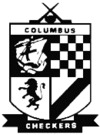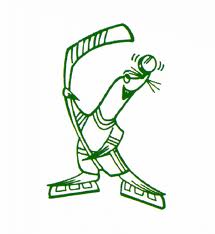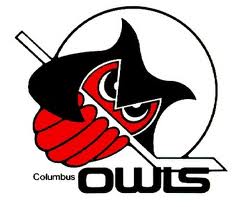Checkers, Owls, Seals

Columbus Checkers, 1966-70
The Columbus Checkers became the first professional hockey team in Columbus playing at the Ohio Expo Fairgrounds Coliseum. The Checkers, owned by the Schmeltzer brothers (Jerry, Ray and Larry), were part of the now defunct International Hockey League (IHL).
Their first game was an exhibition on October 12, 1966 against the Chicago Blackhawks, featuring future NHL Hall-of-Famers Bobby Hull and Stan Mikita. The game was almost cancelled due to poor ice conditions at the Coliseum. Hull and Mikita, citing safety reasons, initially threatened not to play, but ultimately relented playing just one period. It was a rather inauspicious way to introduce professional hockey to Columbus. The rocky start foreshadowed the franchise’s future instability.
The Checkers were led by player/coach Moe Bartoli who led the team in scoring the inaugural season and forward Bert Fizzell. Fizzell established team records for goals (153), assists (245) and points (398) during his four seasons with the team.
Under Bartoli, the Checkers finished in last place with a 23-48-1 record during its inaugural season, but rebounded with a third place finish (32-30-10, 74 pts) in 1967-68, earning their first playoff berth. However, after a rift with ownership, Bartoli left the franchise.
Jack Turner took over as the team’s player/coach at the start of the 1968 season as Bartoli focused solely on playing. Under Turner, Columbus failed to make the playoffs finishing sixth place (26-37-9, 61 pts) in 1968-69 and last place in1969-70 (24-36-12, 60 pts).
The Columbus Checkers folded in the spring of 1970 due to low attendance.

Columbus Golden Seals, 1971-73
The Columbus Golden Seals operated as a farm team to the NHL’s California Golden Seals. The owner of the NHL Seals, Charlie Finley, who also owned the major league baseball’s highly successful and colorful Oakland A’s, acquired the International Hockey League franchise rights to the dormant Columbus Checkers. After a one year absence, hockey was back in Columbus as the “Baby Seals” became the parent club’s IHL affiliate.
The Golden Seals were dismal on the ice posting a lackluster 15-55-2 record in 1971-72 under head coach Terry Simpson. Finley lured the popular Moe Bartoli back to Columbus in hopes of reviving the team’s fortunes, but the team followed up with an even worse 10-62-2 record in 1972-73. The Seals only lasting legacy were their bright gold, green and white uniforms and their white skates, a Finley trademark.
In 1973, Finley sold the Seals to British born investment broker Al Savill who renamed the team the Columbus Owls.

Columbus Owls, 1973-77
The Columbus Owls became the third franchise to try to make a go of hockey in Central Ohio. Owner Al Savill kept Moe Bartoli in place as head coach of the IHL franchise. Bartoli secured an affiliation with the St. Louis Blues and stocked the franchise with physical blue collar style players including Steve Lyons, Mike Thompson and Bill Bond. The retooled Owls totaled 2,437 penalty minutes in 1973-74.
The next season the Owls had success, finishing second (40-32-4, 84 pts) in their division. The team relied on its defense, led by Columbus native goaltender Bill Yeo. However, playoff games were shifted to Troy, Ohio due to event conflicts at the Coliseum. With no home ice advantage the Owls bowed out after reaching the semifinals.
Savill next made a major league investment, becoming owner of the Pittsburgh Penguins for two seasons beginning in 1975.
The Owls finished the 1975-76 a disappointing 24-44-7 (56 pts) failing to qualify for the postseason. It was Bartoli’s last season as coach, but he continued as the franchise’s general manager. Ron Ullyot took over as the team’s head coach.
Ullyot led the revitalized Owls to a second place finish (35-30-11, 81 pts) in 1976-77. Unfortunately, it wasn’t enough to save hockey in Columbus. Savill, frustrated by the fact that the Coliseum was again unavailable for the playoffs and by the fact there was no plan by the Fairgrounds to fix the situation, elected to move the Owls to Dayton.
Hockey would go dormant for 14 years, until the arrival of the East Coast Hockey League Columbus Chill in 1991.

This post has no Comment